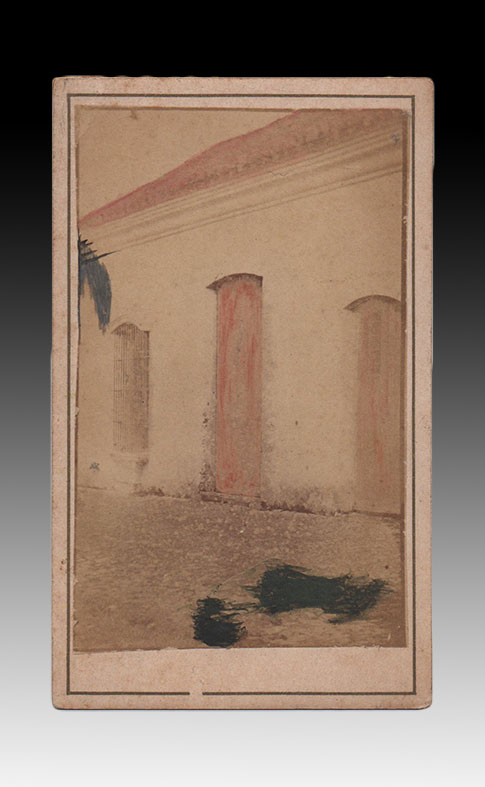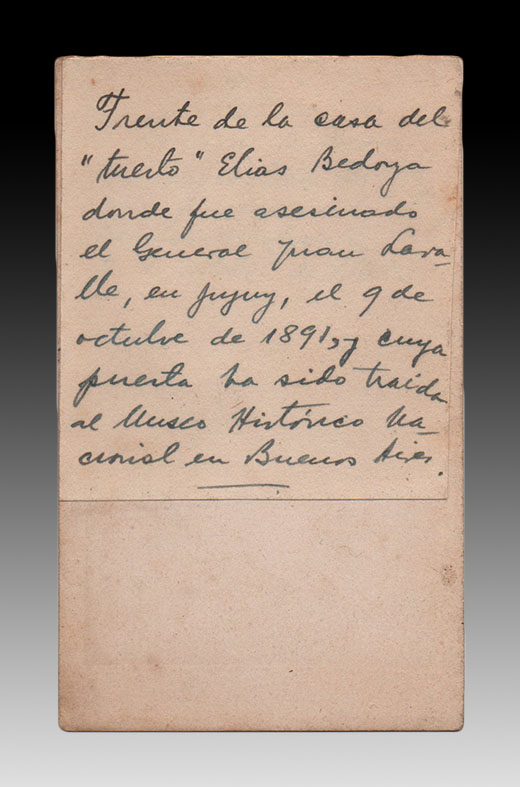The house where General Juan Lavalle died.
San Salvador de Jujuy. Circa 1865.
Exceptional historical document. Vintage photograph on albumen paper and illuminated (colored) in the business card format - in French "carte-de-visite" - in the size of 9 x 6 cms / 3.54 x 2.36 in. The nineteenth-century work is mounted on a secondary white cardboard support with a colored perimeter frame. The photographer - in this copy, unidentified - pointed his camera towards the front of that colonial house with a tile roof, barred windows and the famous thick wooden door. You can see the irregular cobblestones of the street. The print has some subsequent ink stains.
We must point out that in modern times a paper was glued to the back of the original cardboard of the photograph and with the following handwritten legend: "In front of the house of" one-eyed "Elias Bedoya where General Juan Lavalle was assassinated, in Jujuy, the October 9, 1841, and whose door has been brought to the National Historical Museum in Buenos Aires".
We are probably facing the oldest urban photographic view in the province of Jujuy. Added to this award is the fact that it is a clearly journalistic visual record, it documents the house in San Salvador de Jujuy where the unitary leader General Juan Galo Lavalle (1797-1841) was murdered and in a confused situation.
Lavalle was a warrior of Independence later involved in civil struggles; He arrived on the outskirts of the capital city of the province of Jujuy on October 8, 1841 at the head of 200 men who had been suffering successive defeats. The exhausted troops camped in Los Tapiales de Castañeda, but his chief decided to spend the night in the capital with eight of his most faithful soldiers; On the occasion he was accompanied by the beautiful Damasita Boedo (1818-1880), involved in a complicated love-hate relationship with that blue-eyed blond lover.
At two in the morning they occupied a large house -abandoned in haste by its owners- to spend the night; just four hours later they were hit by a federal party of 14 men and after a series of shots in front and through the door, Lavalle was struck down with a bullet in the throat. Thus began a historical controversy about his death and the famous door impossible to cross with a lead. His supporters finally fled north to Bolivia and, on the banks of a watercourse, "skinned" the corpse, continuing only with the general's bones wrapped in the Argentine flag and accompanied by the beautiful Salta Dámasa Boedo, to finally deposit them in the Cathedral of Potosí.
In 1861 the return was organized and his remains were buried in the Recoleta cemetery. The controversial door is kept in the National Historical Museum and its tall monument presides over the Plaza Lavalle in Buenos Aires.
It should be noted that this original copy was made around the 1860s and its edition was destined to form a central part of the brand-new photographic albums that emerged as a result of the popular "carte-de-visite" fashion. Just a decade after the overthrow in 1852 of his great enemy, Juan Manuel de Rosas (1793-1877), he surely formed part of a political iconography in the family albums of prominent Unitarian families of the time.
S.O.IX-OBL
| AUTHOR | FOTÓGRAFO NO IDENTIFICADO |
|---|
Are you interested in selling some works?
Send us an email briefly indicating
which works you intend to put on sale, and we will respond. click here
Subscribe to our newsletter to be updated.
Check our Newsletters
